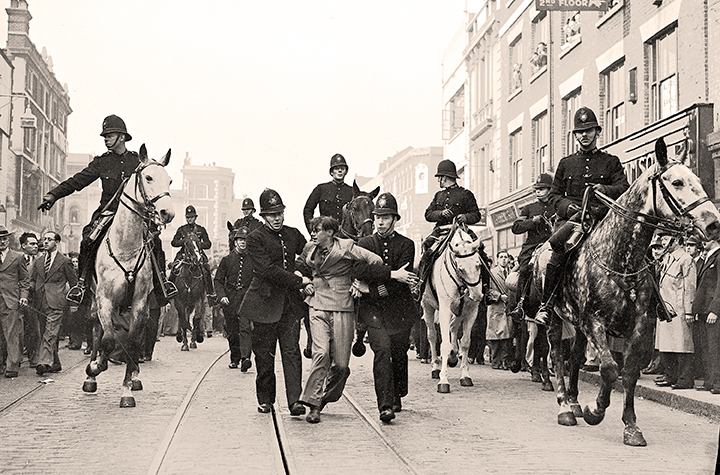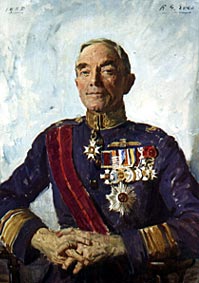Air Vice-Marshall Sir Philip Woolcott Game, GCB, GCVO, GBE, KCMG, DSO was born in Streatham, Surrey in England in 1876, the son of a successful merchant from Worcestershire. Educated at Charterhouse, he then entered the Army through RMA Woolwich, subsequently being commissioned into the Royal Artillery in 1895. Before attending Staff College he saw active service in the Second Boer War (1899 – 1902) and in India. In 1908 he married Gwendoline Margaret Hughes-Gibb.
He first came to the fore as a senior staff officer in the British Army in France in the early days of the Great War. As Gunner Major in France he took part in the battle of Neuve Chapel, winning his DSO the Legion d’Honneur and being mentioned in dispatches on five occasions. As a Lieutenant-Colonel in 1916 he underwent what was for him a highly unwelcome transformation into a senior staff officer in the Royal Flying Corps. This was the result of an urgent plea by Brigadier-General Trenchard to Sir Douglas Haig for a first-rate staff officer to sort things out at the newly established headquarters of the Royal Flying Corps. This Game did so successfully that he remained Trenchard’s right-hand man, not only during the war but through all post-war battles to preserve and then to develop what had become in 1918, the Royal Air Force.
Sir Philip eventually retired from the Air Force in 1929 as Air Vice-Marshal, after which he was appointed Governor of New South Wales. Arriving in Sydney with his family in May 1930 he soon found himself in the midst of a bitter political controversy as tried to hold the ring in a complex series of political gambits, eventually being compelled to dismiss the Australian State Premier, J.T. Lang in 1932. It was a highly controversial move but one, which was, then and later, deemed necessary. On completion of his duty he was made K.C.M.G. and left Australia in January 1935 to succeed his former colleague and First Marshal of the R.A.F., Lord Trenchard, as Commissioner of the London Metropolitan Police.
One of his earliest tasks as Commissioner was the organisation of the crowd control measures for the funeral of King George V. This must have brought back memories, as he had been the officer in charge of the gun carriage, which had borne the coffin of Queen Victoria at her funeral in 1901. State funeral processions are distinct from those of other ceremonial funerals in that the coffin is placed upon a gun carriage of the Royal Horse Artillery, a practice first begun following the death of Queen Victoria.
Queen Victoria’s funeral took place in St. George’s Chapel Windsor. The gun carriage was waiting at Windsor Station, together with several naval and military detachments, who were to escort it to the Chapel. After a considerable wait the special train arrived and the Royal coffin, weighing about 9cwt., was eventually placed on the carriage. Drums began muffled rolls, which reverberated under the station roof, and the cortege started to move. As the horses took up the strain the eyelet hole on the wheel hub, to which the off-side trace was hooked, broke away and caused the end of the trace to whip back and strike the hock of the off-side wheeler. Well trained, the horses did not bolt, but the injured animal, somewhat naturally, plunged to the ground and the entire team had to be unhitched. A naval detachment promptly and gallantly seized the drag ropes and started off with the load along the prescribed route — a tradition was born. No blame was attached to the RHA or to Lieutenant P. W. Game as the cause was deemed to be equipment failure. King Edward presented the gun carriage involved to HMS Excellent.
Sir Philip was also responsible for crowd control during the Battle of Cable Street in 1936, when communist and fascists came to blows on the streets of the East End of London.

The Battle of Cable Street took place on Sunday 4 October 1936 in the East End of London.
Following the outbreak of the Second World War the “Met” had to release huge numbers of experienced officers into the Armed Services and Sir Philip was required to deploy all his ingenuity and staff training to maintain a viable force during the hostilities.
It was at the end of his tenure with Metropolitan Police that one of Sir Philip’s concerns, to provide healthy challenges and activities for young people was addressed in the establishment of the highly successful club — now known as the Sir Philip Game Centre.
He retired as Metropolitan Police Commissioner in 1945, and died at his home in Sevenoaks on 4 February 1961 having served five monarchs and lived in the reign of six, predeceased by one of his sons, killed in action at Taranto, Italy, in 1943.
-
This cleans up the facts…Sir Philip was a fascist supporter and the police sided with the fascists in the 1936 demonstrations….it was not commies against fascists…it was the East End of London against Mosley and his blackshirt thugs.
-
Very interesting article. One small point in para 3: J T Lang was the NSW State Premiere (rather than as the article states “Australian” State Premiere).


2 comments
Comments feed for this article
Trackback link: https://spgcentre.co.uk/sir-philip-game/trackback/